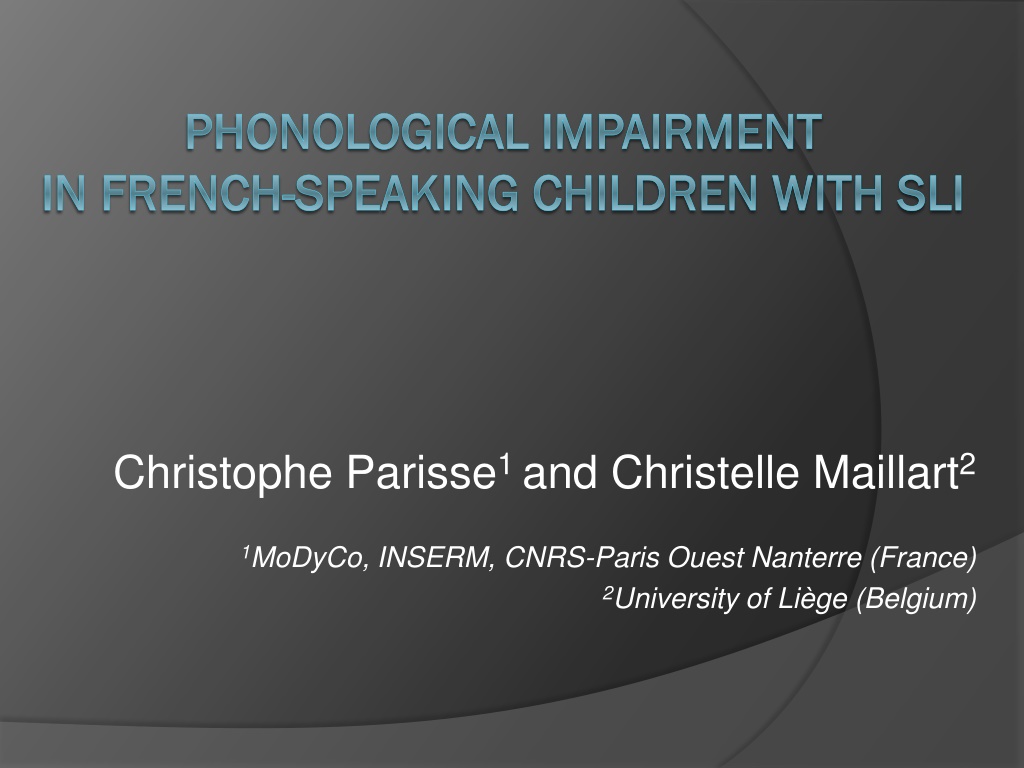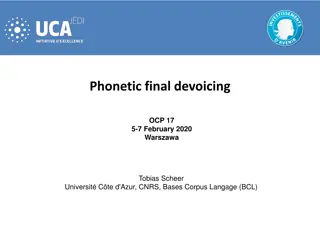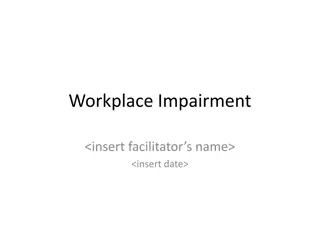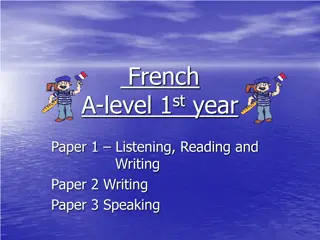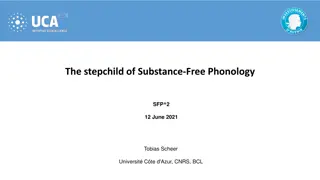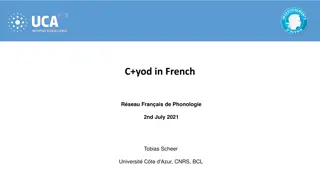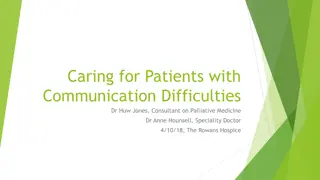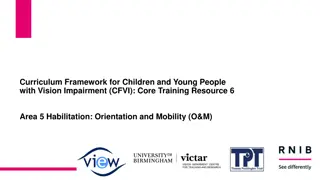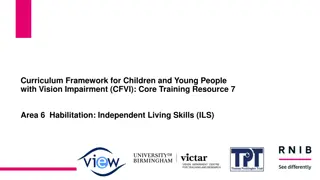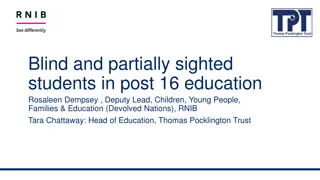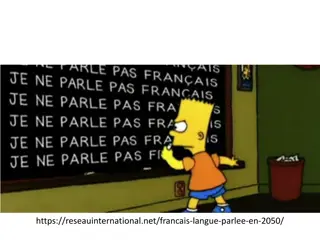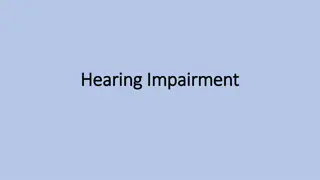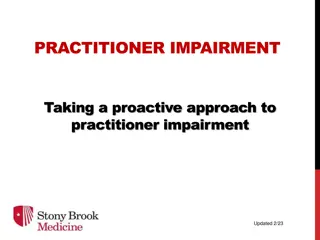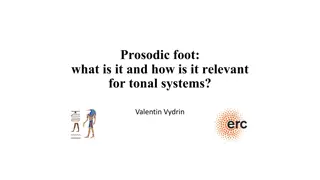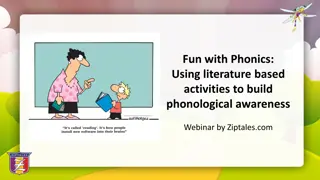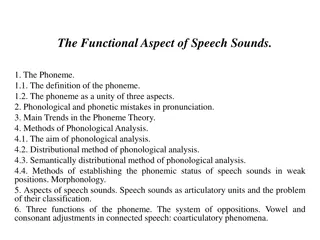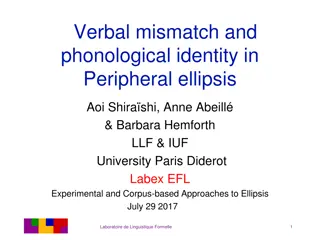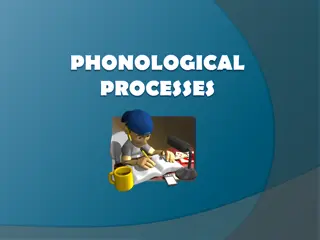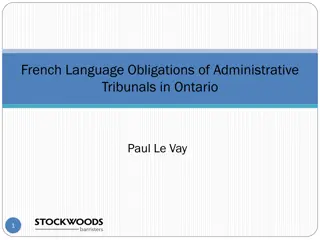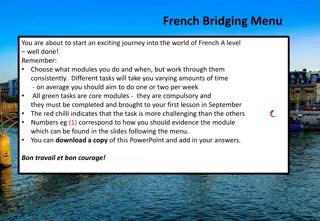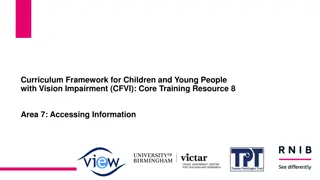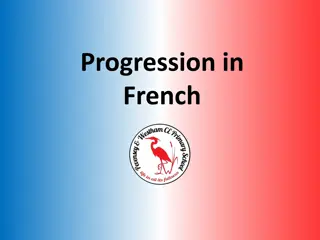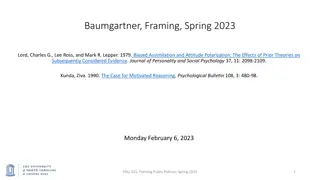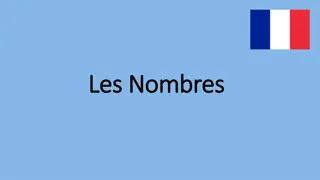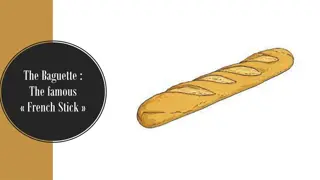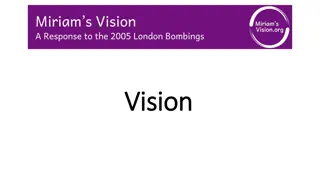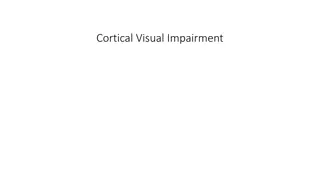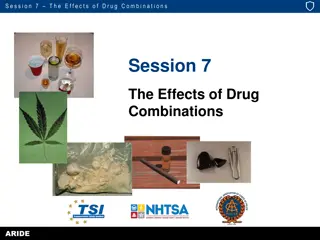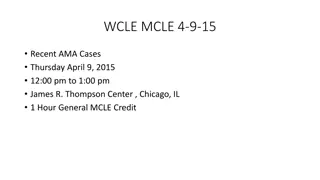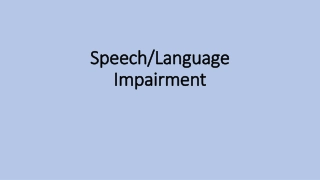Phonological Impairment in French-speaking Children with SLI: Evidence and Origins
This study explores phonological impairment in French-speaking children with SLI, confirming specific difficulties in phonology compared to age-matched peers and across different languages. Evidence suggests phonological delays and deficits, with stronger evidence found through comparison with MLU-matched children. The study aims to determine if there are developmental trends in the phonological deficit among French-speaking children with SLI. Participants include children with varying ages, MLU, and phonetic inventories.
Download Presentation

Please find below an Image/Link to download the presentation.
The content on the website is provided AS IS for your information and personal use only. It may not be sold, licensed, or shared on other websites without obtaining consent from the author. Download presentation by click this link. If you encounter any issues during the download, it is possible that the publisher has removed the file from their server.
E N D
Presentation Transcript
PHONOLOGICAL IMPAIRMENT PHONOLOGICAL IMPAIRMENT IN FRENCH IN FRENCH- -SPEAKING CHILDREN WITH SLI SPEAKING CHILDREN WITH SLI Christophe Parisse1 and Christelle Maillart2 1MoDyCo, INSERM, CNRS-Paris Ouest Nanterre (France) 2University of Li ge (Belgium)
Potential origins of SLI behaviour grammatical deficit memory deficit limitation of working capacity phonology acoustics
Evidence for phonological deficit phonological delay when children are compared with age-matched control children (Stoel-Gammon, 1989; Paul & Jennings, 1992 ; Rescorla & Ratner, 1996) productions are quantatively different but qualitatively similar productions are similar to young children s productions
Strongest evidence for phonological deficit comes from comparison with MLU-matched children if there are phonological deficits for the same language level, then phonology is a special difficulty for children with SLI
Previous results SLI < MLU even taking into account their language delay this was found for different languages (different phonology, different syntax) the details of the results obtained vary from one language to another Bortolini & Leonard (2000) English, Italian Owen, Dromi, Leonard (2001) Hebrew Aguilar Medivilla , Sanz-Torrent & Serra-Raventos (2002) Spanish / Catalan
Goals of the study Confirm that children with SLI show specific difficulties in phonology when compared with children with the same language level and confirm that this is a cross-language finding Inquire whether there are specific phonological deficit/difficulties in French- speaking children with SLI Confirm whether there is or not a developmental trend in the deficit (are errors qualitatively different and more common in older children?)
Participants Type Age MLU Phonetic inventory 23.1 (2.75) 17.9 (4.49) 22.5 (3.62) 19.5 (3.50) Nb. of participants 8 8 8 8 SLI SLI Controls Controls 8;6 (1;1) 3.7 (1.5) 3;11 (0;7) 2.4 (0.3) 4;0 (0) 2;3 (0) 3.7 (1.0) 2.7 (0.8) Matched by MLU (language match) Age of control children corresponds to mean MLU age of children with SLI
Task Spontaneous language free play situation for the younger children conversation with adult partner for the older children Children can avoid forms that are difficult for them, so that results tend to be more difficult to obtain, but are also more reliable
Phonetic transcription CHAT format At least two persons checked all transcriptions Transcriptions were corrected until 100% agreement was reached Total utterances: 4158 Total words: 13312
Procedure Utterance level Word level Syllable level Phoneme level
Example of transcription *CHI:sait pas nager (cannot swim) %pho: se pa la e (child phonology) %mod: se pa na e (adult phonological target) Phonological errors
Automatic extension of coding schema *CHI: cuisine (..) deux salons . [% kitchen (.) two saloons] %pho: kwizEn (..) ty zalo~ %mod: kwizin (..) d2 salo~ %syl: kwizin kwi.zin %syl: d2 d2 %syl: sal sa.l kwizen ty zal kwi.zen ty za.l *CHI: apr s la r cr de dix heures +... [after the ten o clock break] %pho: apE a ateeRe t@ ti z9R %mod: apRE la RekRe d@ di z9R %syl: apRe a.pRe %syl: la la %syl: RekRe Re.kRe ateeRe %syl: d2 d2 %syl: di di %syl: z2R z2R ape a a.pe a a.te.e.Re t2 ti z2R t2 ti z2R
*CHI: %pho: %mod: %syl: %syl: %syl: %syl: %syl: %syl: la t l sur l' armoire hein@i . [% the tv on the sideboard] la tele syR l aRmwAR e~ la tele syR l aRmwAR e~ la la la tele te.le tele syR syR syR l l l aRmwAR aR.mwAR aRmwAR aR.mwAR la te.le syR l *CHI: sideboard] %pho: %mod: %syl: %syl: %syl: %syl: %syl: %syl: et la radio (.) sur l' armoire . [% and the radio on the e la RadjO (.) syR l aR::mwAR e la RadjO (.) syR l aR::mwaR e e la la Radjo Ra.djo syR syR l l aRmwaR aR.mwaR aRmwAR aR.mwAR e la Radjo syR l e la Ra.djo syR l
*CHI: [% and the trash can (.) of table (.) on the sideboard] %pho: e a pubEl (.) d@ tAp (.) syR l amwA %mod: e la pubEl (.) d@ tabl (.) syR l aRmwaR %syl: e e %syl: la la %syl: pubel pu.bel pubel pu.bel %syl: d2 d2 %syl: tabl tabl %syl: syR syR %syl: l l %syl: aRmwaR et la poubelle (.) de table (.) sur l' armoire . e a e a d2 tAp syR l aR.mwaR d2 tAp syR l amwA a.mwA
Utterance level 120 99,4 98,5 96,5 95,6 94,5 100 86,5 75 74,8 % intelligible utterances % comprehensible utterances 80 60 40 20 0 Controls Low-MLU SLI Low- MLU Controls High-MLU SLI High- MLU Age effect onky for both measures (p < .001)
Word level (correct adult target) 89,9 100 74,5 72,6 72 80 60 Controls SLI 40 20 0 Low-MLU High-MLU Age effect (p = .002), type effect (p = .02), and interaction age x type (p = .009)
Syllable inventory Type SLI SLI Controls Controls MLU CV Haut 46 (10) 24 (4) 4 (2) 3 (2) 8 (3) Bas 57 (7) 25 (6) 2 (2) 1 (0) 5 (4) Haut 52 (3) 16 (3) 3 (1) 2 (1) 11 (2) 15 (2) Bas 57 (6) 22 (5) 3 (2) 1 (1) 8 (4) V VC CCV CVC others 14 (5) 10 (3) 9 (3) Green arrows: age effect Blue arrows: type effect
% correct syllables CV V VC CCV CVC others SLI SLI Controls High 98,4 Controls Low High 95,4 98,1 65,7 71,2 74,9 Low 91,3 98,8 71,2 100 96,1 68,3 94,3 94,1 97,2 65,4 82,4 64,6 76,8 61,5 92 57,6 50 50,4 Green arrows: age effect Blue arrows: type effect Red circle: interaction age x type
Percentage of consonant correct Automatically computed (starting from syllable structure) PPC = number of correct consonants / (number of correct target consonants + number of omitted consonants + number of added consonants)
Percentage phonemes correct (PPC) 100 92,6 90 80,3 77 75,5 80 70 60 Controls SLI 50 40 30 20 10 0 Low-MLU High-MLU Age effect (p = .0001), type effect (p < .004) interaction age x type (p = .02)
Percentage consonants correct (PCC) 100 89,3 90 75,8 80 72 68,4 70 60 Controls SLI 50 40 30 20 10 0 Low-MLU High-MLU Age effect (p = .0008), type effect (p = .02), no interaction age x type
Percentage vowels correct (PVC) 120 96,3 100 84,7 83,8 82 80 Controls SLI 60 40 20 0 Low-MLU High-MLU Age effect (p < .0001), type effect (p < .0001), interaction age x type (p = .002)
Discussion Utterances age effect only Words all effects Syllables mostly age effect Phonemes all effects
Special difficulties in phonology for children with SLI Results for words were confirmed by measures on phonemes (and on syllables to a smaller extent) Specific result for French children deficit on syllable structure was not important deficit for vowels as well as deficit for consonants
Developmental effect? There was no difference between the two groups of younger children There was an important difference between the two groups of older children Note: this was not a developmental study
Children with SLI seem to develop phonological competence slower than control children They appear as if they are stuck at a low level of phonological competence A consequence is that children with SLI may have more problems when it becomes necessary to segment words into syntactic components
Follow up on the previous study To understand the nature of the children s problems and to test phonologically-based theories it is necessary to test the interplay between phonology and syntax not only verbs (most theories esp. grammatical are tailored to the difficulties of children with SLI with the verbs) evaluate phonology and syntax for all word categories
Complexity as a factor Does complexity (phonology and syntax) account for children difficulties? Organisation of the current student Evaluate (theoretical) complexity for all syntactic categories Measure performances for all categories Compare theoretical complexity and children s performances Check whether results in phonology are correlated with results in syntax
Phonological complexity Data was computed for this study using the database Lexique and work about syllable complexity Lexique database was limited to words attested in child directed speech Complexity was automatically computed for each word and average complexity was computed for each syntactic category (using Paradis & Beland (2002) work about syllabic complexity) 1.21 determiners, 1.21 subject pronouns, 1.92 strong pronouns, 1.99 prepositions, 2.21 auxiliaries, 2.57 adverbs, 2.61 nouns, 2.66 unmarked verbs, 3.03 marked verbs Four types of syntactic categories for phonological complexity
Syntactic complexity Feature Number of Value features Adverb None 0 10 Auxiliary verb Tense, number(1/2), person 2.5 2 Determiner Gender, number 2 4 Noun None (number and gender for some nouns) 0.5 8 Preposition None 0 10 Strong pronoun Gender, person 2 4 Subject pronoun Gender, person 2 4 Unmarked verb Tense (non-pronounced), number (1/2) 1.5 6 Marked verb Tense (pronounced), number(1/2) 1.5 6
Complexity for phonology and syntax phono cpx 5 syntactic cpx 10 adverb determiner 10 4 noun 5 8 preposition 7.5 10 strong pronoun 7.5 4 subject pronoun 10 4 marked verb 5 6 auxiliary 7.5 2 unmarked verb 2.5 6 unmarked verb = present tense (1s, 2s, 3s, 3p) + imperative 2s marked verb = mostly inf. and pp. (+ all other forms)
Methodology Participants 24 French-speaking children 12 children with SLI (mean age: 7;7 ans, MLU: 3.82) 12 control children (mean age: 4;0, MLU: 3.70)
Task Task spontaneous language production (semi- directed questions and answers) phonological transcription (CHAT) morphosyntactic tagging (CLAN, MOR & POST) 3052 utterances (1474 SLI ; 1578 Ctrl) 11702 words (5606 SLI ; 6096 Ctrl)
Example of transcription *CHI:sait pas nager (cannot swim) %pho: se pa la e (child phonology) %mod: se pa na e (adult phonological target) %mds:il se pa na e (adult target with syntactic correction) Phonological errors Syntactic errors
Morphosyntactic line was added automatically *CHI: wah@i (.) un (.) grand (.) arbre avec (..) les trucs %mor: co|wah@i det|un adj|grand n|arbre prep|avec det|les n|truc adv|comme+ a . %pho: wa: (.) 9~ (.) gRa~ (.) da aEk (..) lE Ry gOmza %mod: wa: (.) 9~ (.) gRa~ (.) aRbR avEk (..) lE tRyk komsa %mds: wa: (.) 9~ (.) gRa~ (.) aRbR avEk (..) dE tRyk komsa comme+ a . Target syntactic line was added manually *CHI: joue des jeux +... %mor: %pho: %mod: %mds: v|jouer det|des n|jeu +... Zu tE Z2j Zu dE Z2 (pro:subj|o~) Zu (prep|a) dE Z2 *CHI: elle travaille (.) mais <mon pa(pa)> [//] mon papa il parce+que +... %mor: pro:subj|elle v|travailler conj|mais det:poss|mon n|papa pro:subj|il v|travailler prep|de det|la n|nuit conj|parce+que +... %pho: E tafa (.) mE <mo~ pa>[//] mo~ papa i tava d@ la myi (..) pat@ %mod: El tRavaj (.) mE <mo~ pa>[//] mo~ papa il tRavaj d@ la nyi (..) paRsk %mds: El tRavaj (.) mE <mo~ pa>[//] mo~ papa il tRavaj {d@} la nyi (..) paRsk travaille de la nuit (..)
Results Phonological errors adv det noun prep pro p. sbj verb aux verb mark 48% non. 56% Sli 67% 89% 62% 81% 69% 73% 92% Ctr 92% 96% 84% 94% 95% 91% 88% 98% 69% p.= .0003 .018 .0001 .024 .002 .004 .0001 .15 (NS) 7.5 .025 Theory 5 10 5 7.5 7.5 10 5 2.5 Large difference between the groups At the same MLU level, phonology is weak for children with SLI (confirmed previous results)
Results Syntactic errors adv det nom prep pro p. sbj verb aux verb mark non. Sli 99% 88% 99% 84% 97% 73% 96% 95% 93% Ctr 99% 95% 100% 94% 96% 81% 97% 99% 95% p.= .92 NS .005 .095 NS .0012 .94 NS .27 NS .46 NS .18 NS .20 NS Theory 10 4 8 10 4 4 6 2 6 Not much difference between the groups With the same MLU, significant differences were found for determiners and prepositions
Correlations between theoretical complexity and children s results phono cpx 0,79* syntax cpx -0,34 SLI phono CTR phono SLI syntax CTR syntax 0,76* -0,22 -0,56 0,18 -0,63 0,25
Discussion Negative correlations do syntax and phonology behave differently? Positive correlations strong link between phonological complexity and phonological errors Not enough grammatical errors to obtain significant correlation measures? Task to not sensitive enough to grammatical difficulties?
Missing elements Some results are not explained by pure phonological theory determiner worse than subject pronouns and verbs worse than nouns (for phonology and syntax) but they have similar phonological complexity errors with prepositions results for adverbs and auxiliaries better than expected results for strong pronouns for SLI worse than expected All syntactic errors do not reflect phonological complexity even if phonological complexity is even better tailored to the specificities of children s productions
Future developments Phonological complexity appears to be a cornerstone for all (phonological) theories about specific language impairment only phonological complexity predicts correctly the children s errors But
to be improved If complexity works for phonology, why couldn t it be the case for syntax maybe because we have a bad definition of syntactic complexity or of syntax (proposal: base on children s specific productions, not on adult language) Semantic/syntactic seems interesting because it could explain some results with prepositions, nouns/verbs, but needs to be better defined
Repetition study different task Correct Mathieu et toi, vous allez jouer sur le tobbogan (Matthew and you, you are going to play on the slide). 13 (0.82) La confiture de fraise, je la mange sur du pain (The strawberry jam, I m eating it on a slice of bread). 12 (0.67) Including one grammatical error (by substituting one word for another) Marie et moi, vous allons jouer la balan oire (number error: Mary and me, you are going to play on a swing) 13 (1.15) Le miel du jardin, je la mange sur du pain (gender error: the honey from the garden, I m eating her on a slice of bread). 12 (1.05)
Seven grammatical categories Subject pronoun Object pronoun Auxiliary Determiner Preposition Noun Verb 70 correct utterances, 70 erroneous utterances Children matched by comprehension level (ECOSSE)
Comparison between children with SLI and language level controls Analysis bears on the correct, incorrect, or absent repetition of the target word in the utterances after the child s repetition Examples of incorrect repetition of target Target: mes cousines pr f r es, elles apporteront des cadeaux. Child: mes cousines pr f r es, ils apportent des cadeaux. Target: mes chaussures. Child: mes chaussures. quand j' tais petit, je ne saurai pas lacer quand j' tais petit, je ne sais pas xx lacer
Grammatical target Ungrammatical target Subjects No analysis Target Target reproduced 3.8 6.4 4.4 8.5 4.6 9.1 6.5 8.4 5.8 8.2 No analysis Error Error reproduced 1.1 3.4 1.9 6.5 Syntactic category changed corrected 6.2 5.3 3.9 2.4 3.1 1.1 2.5 1.1 4.4 0.8 2.2 1.2 2.1 0.9 3.1 2.5 3.2 0.5 0.9 0.1 1.3 0.4 2.1 0.8 2.6 1.3 4.2 1.0 SLI Subject pronoun Control SLI Object Pronoun Control SLI 2.8 4.8 2.4 Auxiliary Control 1.5 2.8 1.9 2.4 1.6 4.6 4.9 3.1 5.4 1.9 3.9 2.3 5.0 2.2 6.4 SLI Determiner Control SLI Preposition Control SLI 1.4 0.6 8.1 2.9 2.1 4.9 Noun Control 0.9 3.9 1.3 0.0 2.5 0.6 9.1 3.6 8.1 2.1 1.9 1.6 1.0 5.0 2.2 6.9 3.1 6.2 SLI Verb Control
Spontaneous vs non spontaneous production Is non-spontaneous production just more difficult ? With spontaneous production children are able to produce memorized (and non decomposed) forms With non-spontaneous, they have to be creative and to decompose/recompose memorized material This could be where children with SLI have the most severe difficulties
Goal: Using PHON to analyse the cases of incorrect repetition compare with other material *REC: dit la v rit . *CHI: ce gar on il est pas une menteuse il dit la v rit . %com: Nom feminin erreur %cod: . . 3 5 ce gar on n'est pas une menteuse il *REC: prend pour aller jouer. *CHI: les camions orange i prend pour aller jouer. %com: Proobj anaphore imm diate correct %cod: . 4 . 4 les camions orange mon fr re les
